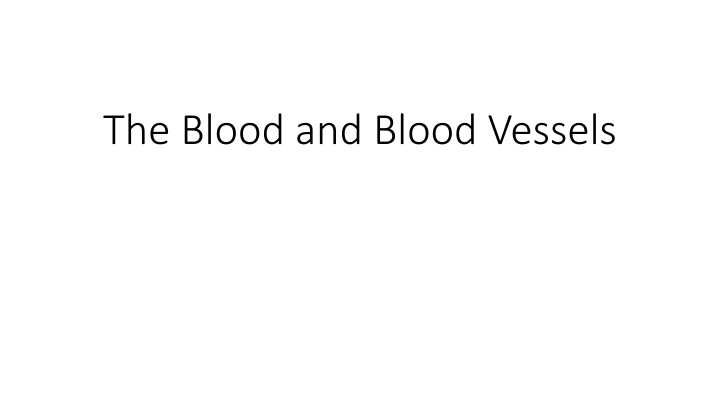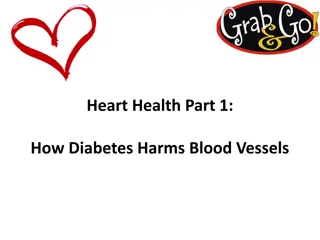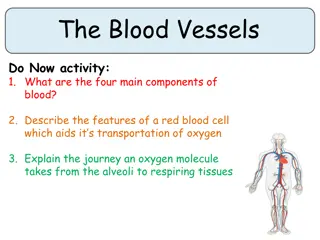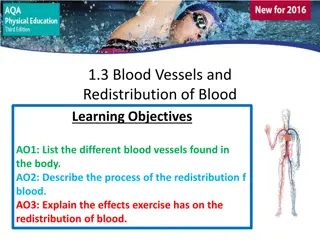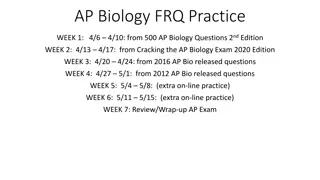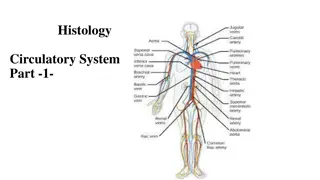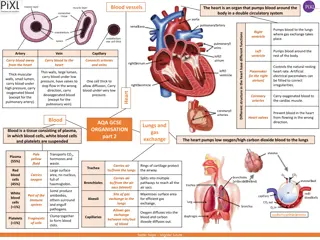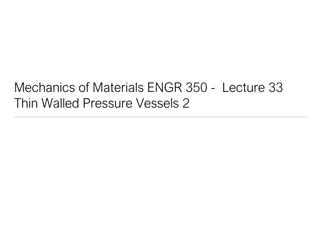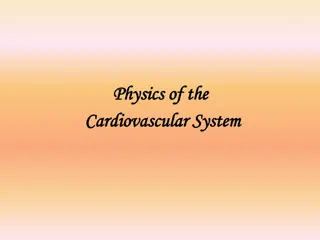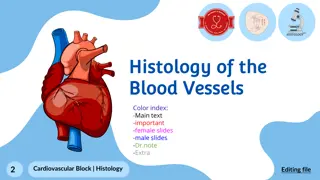The Blood and Blood Vessels
Learn about the components of blood including plasma proteins, red and white blood cells, platelets, and the function of capillaries, arteries, and veins in the circulatory system.
Uploaded on Mar 01, 2025 | 2 Views
Download Presentation

Please find below an Image/Link to download the presentation.
The content on the website is provided AS IS for your information and personal use only. It may not be sold, licensed, or shared on other websites without obtaining consent from the author.If you encounter any issues during the download, it is possible that the publisher has removed the file from their server.
You are allowed to download the files provided on this website for personal or commercial use, subject to the condition that they are used lawfully. All files are the property of their respective owners.
The content on the website is provided AS IS for your information and personal use only. It may not be sold, licensed, or shared on other websites without obtaining consent from the author.
E N D
Presentation Transcript
Terminology of the Blood Terminology of the Blood Blood brings oxygen and nutrients to body cells and removes waste products Whole blood is made up of plasma, which is a liquid portion, and the formed elements it contains. Blood plasma, which is clear and straw-colored, is composed mostly of water (91%), along with proteins and other nutrients in solution, such as water- soluble vitamins and minerals. The three main classes of blood plasma proteins are albumins, globulins, and fibrinogens. Two other terms that name common blood proteins immunoglobulins) and lipoproteins. Plasma is the medium for circulating blood cells. It also provides nourishment to body cells and removes the waste products from cellular metabolism. are antibodies (also known as
Formed Elements (Erythrocytes, Leukocytes, and Platelets) Formed Elements (Erythrocytes, Leukocytes, and Platelets) Erythrocytes are red blood cells, abbreviated RBC, and leukocytes are white blood cells, abbreviated WBC. Red blood cells make up 99.9% of the formed elements in the blood. Hemoglobin (Hb) (hem/o means blood ; -globin means protein ), a protein in the cell, which is abbreviated Hb and binds only to RBCs, gives blood its red color. Each RBC contains approximately 280 million Hb molecules. A single drop of blood contains about 260 million red blood cells. The number of white blood cells present in a drop of blood is only 35,000 or so, although WBCs are not much larger than the RBCs. White blood cells do not all do the same job and are not all the same size. However, all WBCs are at least slightly larger than RBCs. In fact, the WBCs of one category are double the size of RBCs. WBCs play a n essential role in the body s immune responses, and defense against harmful organisms. Some destroy bacteria by means of phagocytosis (phag/o means to ingest ). their number usually increases during an infection. There are five types of WBCs, lymphocytes, monocytes, neutrophils eosinophils and basophils. Platelets, which are very small in comparison to both RBCs and WBCs, are formed elements that are important in the coagulation process. They are produced in the bone marrow and vary somewhat in shape.
Formed elements in blood. Formed elements in blood.
Capillaries, Arteries, and Veins Capillaries, Arteries, and Veins Capillaries The capillaries (singular: capillary) are a good place to start in a study of the blood vessels, not because they are the largest of the vessels; on the contrary, they are the smallest. They are mentioned first, however, because they are the most numerous and because they deliver nutrients from the blood to the body's cells. The transfer of blood to the capillaries begins in large vessels and progresses through vessels of ever-diminishing size. Arteries Arteries (singular: artery) carry blood away from the heart and, eventually, to the capillaries. Arteries contain muscle tissue, which allows them to vary their diameters. Two terms are associated with this action: they are vasoconstriction (a narrowing of the artery's diameter) and vasodilation (an enlarging of the artery's diameter). When the muscle tissue contained within an artery contracts, vasoconstriction occurs, thereby producing a resistance that increases blood pressure. When the muscle tissue relaxes, vasodilation occurs to effectively lower the blood pressure. All arteries have this capability, but in varying degrees, depending on their function. The arteries nearest the heart must be able to accommodate the large volume of blood it pumps out with each beat. Artery diameters become smaller as they get nearer to the capillaries. The three kinds of arteries are conducting arteries, muscular arteries, and arterioles.
Conducting Arteries Conducting Arteries Conducting arteries, sometimes called elastic arteries, can have an inside diameter as Conducting arteries, sometimes called elastic arteries, can have an inside diameter as great as an inch. The aorta is an example of a conducting artery. The pulmonary artery great as an inch. The aorta is an example of a conducting artery. The pulmonary artery and the aortic trunk are examples of conducting arteries, which move blood away and the aortic trunk are examples of conducting arteries, which move blood away from the heart. Three major conducting arteries branch from the aortic arch, as from the heart. Three major conducting arteries branch from the aortic arch, as shown in the Figure below. They are the brachiocephalic trunk, the left common shown in the Figure below. They are the brachiocephalic trunk, the left common carotid artery, and the left subclavian artery. Both the right subclavian artery and the carotid artery, and the left subclavian artery. Both the right subclavian artery and the right common carotid artery attach to the brachiocephalic trunk. right common carotid artery attach to the brachiocephalic trunk. Conducting arteries.
Medium-Size Arteries Medium-size arteries, sometimes called muscular arteries (because they contain a lot of muscle tissue), typically have an inside diameter of about one-sixth of an inch-roughly the height of the letters h and l in this sentence. The external carotid artery in the neck is an example of a medium-size artery. Arterioles Arterioles are the smallest arteries, with an average inside diameter of 0.0018 of an inch, or about 1/100 the size of a medium-size artery. Arteries and arterioles connect to the capillaries, which can be as tiny as one blood cell (or about one- fourth the size of an arteriole) in diameter (see the figure below) Schematic diagram of the arteriole-capillary-vein network.
Veins Veins carry blood back to the heart. They follow the same path as the arteries (with blood flowing in the reverse direction, of course). Also, like the arteries, they vary in diameter, becoming larger as they approach the heart because of the increasing volumes of blood they must carry. The vein counterparts of the conducting arteries are the superior vena cava and the inferior vena cava. Together, they are known as the venae cavae, the Latin plurals for vena and cava. All the other large veins of the body system drain into one or the other of these. The counterparts of the muscular arteries and arterioles are the medium veins and venules. As its name implies, the superior vena cava drains blood from the upper body, including the head, neck, shoulders, and arms. The inferior vena cava, likewise, receives blood from the lower body, the dividing line being the diaphragm. The Superior Vena Cava The superior vena cava collects the blood returning from the cranium from smaller veins, such as the great cerebral vein and the internal jugular vein, which runs alongside the common carotid artery. The brachiocephalic veins collect returning blood from the vertebral vein and then connects up with the azygos vein, which in turn connects to the superior vena cava, often referred to by its abbreviation: SVC. The Inferior Vena Cava Blood entering the inferior vena cava (IVC) includes that returning from the lower limbs, spinal cord, liver, kidneys, and reproductive organs. The names of these veins include the digital, tibial, femoral, and lumbar veins, all of which are familiar enough to you by now to indicate what parts of the body they serve. The gonadal, hepatic, and renal veins serve the following parts of the body: the reproductive organs, the liver, and the kidneys, respectively.
COMMON WORD ELEMENTS RELATED TO THE BLOOD AND BLOOD VESSELS Element Refers to ang/i/o arteri/o -ectasis vessel artery Dilation -emia hem/o; hemat/o Blood Blood thromb/o Clot vas/o vascul/o ven/o Vessel Vessel Vein
Blood and Blood Vessel Disorders and Procedures Term aneurysm angiitis (also vasculitis) angiogram angiography Definition a bulge in an artery (or a heart chamber) inflammation of a blood vessel the printed record obtained through angiography radiography of a blood vessel after injection of a contrast medium angiopathy (also vasculopathy) angioplasty angiospasm angiostenosis angiotomy arteriolitis arteriopathy arteriostenosis arteritis hemolysis hemopathy hemorrhage vasculitis (also angiitis) vasospasm any disease of blood vessels surgical repair of a blood vessel spasm in blood vessels narrowing of a blood vessel incision into a blood vessel inflammation of the arterioles any disease of the arteries narrowing of an artery inflammation of an artery or arteries change or destruction of red blood cells any disease of the blood discharge of blood inflammation of a vessel spasm in blood vessels (angiospasm)
